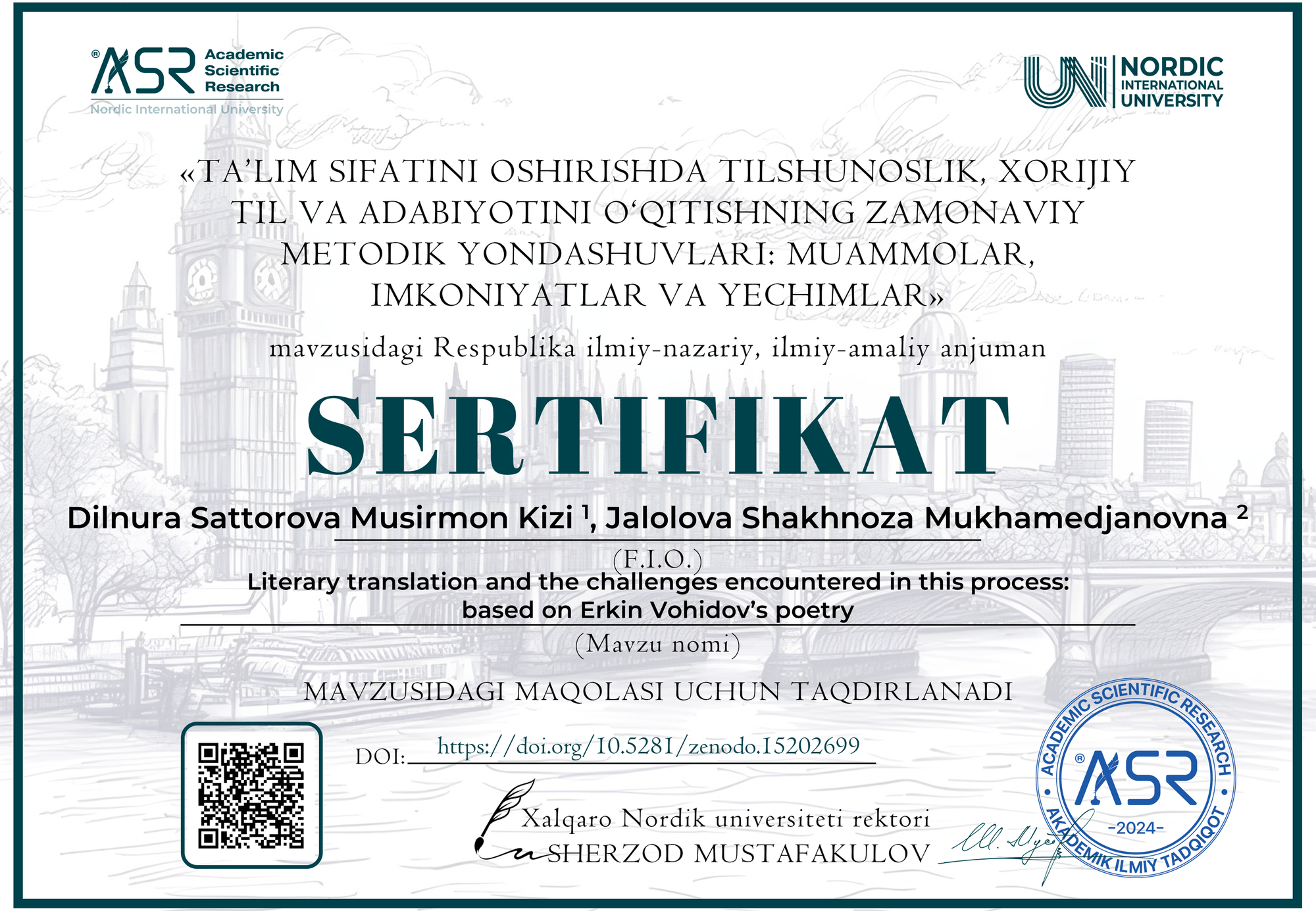Dilnura Sattorova Musirmon Kizi 1, Jalolova Shakhnoza Mukhamedjanovna 2

DOI: https://doi.org/10.5281/zenodo.15202699
Zenodo community: https://zenodo.org/records/15202699
Nordic_press journal: https://research.nordicuniversity.org/index.php/nordic/article/view/2364
MAQOLANI YUKLAB OLISH
SERTIFIKATNI YUKLAB OLISH
REVIEW:
The article by Dilnura Sattorova and Shakhnoza Jalolova provides a comprehensive analysis of the linguistic, cultural, and stylistic challenges faced by translators of literary works, specifically focusing on the poetry of the renowned Uzbek poet Erkin Vohidov. The authors delve into the complexities of literary translation, exploring both theoretical and practical aspects of this intricate process.
The introduction effectively establishes the significance of translation as a bridge between cultures, highlighting the unique challenges of translating literary works. The authors emphasize that literary translation is not merely about converting words from one language to another but about maintaining the aesthetic, emotional, and cultural essence of the original text. This observation is particularly relevant when dealing with poetry, where nuances such as rhythm, metaphorical expressions, and cultural symbolism play a crucial role.
A central theme in the article is the lexical difficulties encountered in translating Vohidov’s poetry. The authors adeptly discuss various challenges, such as the translation of metaphorical expressions, idiomatic phrases, and culturally specific terms that may not have direct equivalents in English. They provide examples of idiomatic expressions from Vohidov’s work, such as “ko‘ngil ko‘zi” (“the eye of the heart”) and “ishq daryosi” (“the river of love”), demonstrating how these phrases, when translated literally, may lose their poetic and emotional significance.
The authors also address the cultural and national aspects embedded in Vohidov’s poetry, which are deeply intertwined with Uzbek history, folklore, and identity. The challenge of translating culturally specific terms, such as "Bobolar ruhi" ("Ancestors' spirit") and "Ona zamin" ("Motherland"), is explored in depth. They argue that such terms require more than just literal translation; they must be contextualized in a way that preserves the cultural and emotional weight of the original.
In terms of practical solutions, the article presents several effective translation strategies. These include contextual adaptation, semantic equivalence selection, and explanatory translation. The authors also emphasize the importance of cultural adaptation, such as using transliteration for national terms or replacing unfamiliar cultural elements with more universally understood equivalents. These strategies are presented as essential tools for overcoming the challenges posed by lexical and cultural differences.
The theoretical framework underpinning the article draws upon established translation theories, such as the importance of understanding the grammatical and semantic relationships between words in the source and target languages. This theoretical grounding enriches the analysis and offers valuable insights into the intricacies of literary translation.
Overall, the article provides a thorough and insightful examination of the challenges faced in translating Erkin Vohidov’s poetry, offering both theoretical insights and practical solutions. It highlights the delicate balance that translators must strike between linguistic accuracy, cultural fidelity, and artistic expression. The study is a valuable contribution to the field of literary translation, particularly for those involved in translating works from Uzbek into English.
The authors' exploration of how to preserve the unique style and emotional depth of Vohidov’s poetry while making it accessible to a wider audience is commendable. Their detailed analysis of lexical challenges, combined with practical translation strategies, offers important guidance for translators and philologists working in this field.



